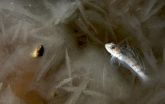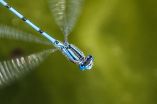(Press-News.org) Antarctic fish that manufacture their own "antifreeze" proteins to survive in the icy Southern Ocean also suffer an unfortunate side effect, researchers funded by the National Science Foundation (NSF) report: The protein-bound ice crystals that accumulate inside their bodies resist melting even when temperatures warm.
"We discovered what appears to be an undesirable consequence of the evolution of antifreeze proteins in Antarctic notothenioid fish," said University of Oregon doctoral student Paul Cziko, who led the research with University of Illinois animal biology professors Chi-Hing "Christina" Cheng and Arthur DeVries. "What we found is that the antifreeze proteins also stop internal ice crystals from melting. That is, they are anti-melt proteins as well."
The new finding was reported in the Proceedings of the National Academy of Sciences.
Five families of notothenioid fish inhabit the Southern Ocean, the frigid sea that encircles Antarctica. Their ability to live in the icy seawater is so extraordinary that they make up more than 90 percent of the fish biomass of the region.
With NSF support, Arthur DeVries discovered antifreeze proteins in Antarctic notothenioid fish in the late 1960s, and was the first to describe how the proteins bind to ice crystals in the blood to prevent the fish from freezing.
The most recent antifreeze discovery was supported by a grant from NSF's Division of Polar Programs.
The Division manages the United States Antarctic Program, through which it coordinates all U.S. research on the southernmost continent and provides the logistical framework to support the science.
This long-standing and continuously refined work on the antifreeze properties of Antarctic fish exemplifies one of the best and defining features of good science," said Charles Amsler, organisms and ecosystems program director in Polar Programs.
"These researchers not only have for decades consistently produced new and exciting finds that contribute to our understanding of Antarctic ecosystems, but very often those new finds have led to new questions and deeper understandings across biology as a whole," he added.
In the new study, the team investigated whether the antifreeze protein-bound ice crystals inside these fish would melt as expected when temperatures warmed.
When researchers warmed the fish to temperatures above the expected melting point, some internal ice crystals failed to melt. Ice that doesn't melt at its normal melting point is referred to as "superheated."
The researchers also found ice crystals in wild notothenioid fish swimming in relatively warmer Antarctic summer waters, at temperatures where they would be expected to be free of ice. By testing the antifreeze proteins in the lab, the team found that these proteins also were responsible for preventing the internal ice crystals from melting.
"Our discovery may be the first example of ice superheating in nature," Cheng said.
A diver himself, Cziko worked with other divers to place and maintain a temperature-logging device in Antarctica's McMurdo Sound, one of the coldest marine environments on the planet. The device recorded ocean temperatures there for 11 years, a substantial portion of notothenioids' lifespan. Not once in that time did temperatures increase enough to overcome the antifreeze proteins' anti-melting effect to completely rid the fish of their internal ice, the researchers report.
The researchers suspect that the accumulation of ice inside the fish could have adverse physiological consequences, but none have yet been discovered.
If the fish are destined to carry ice crystals around all their lives, Cheng said, it is conceivable that ice particles could obstruct small capillaries or trigger undesired inflammatory responses. Cziko likens the potential threat to dangers posed by asbestos in the lungs or blood clots in the brain.
"Since much of the ice accumulates in the fish spleens, we think there may be a mechanism to clear the ice from the circulation," he said.
"This is just one more piece in the puzzle of how notothenioids came to dominate the ocean around Antarctica," he said. "It also tells us something about evolution. That is, adaptation is a story of trade-offs and compromise. Every good evolutionary innovation probably comes with some bad, unintended effects."
The long-term temperature record of McMurdo Sound produced in the study also "will prove to be of great importance and utility to the polar research community that is addressing organismal responses to climate change in this coldest of all marine environments," Cheng said.
INFORMATION:
Clive W. Evans, a professor of molecular genetics and development at the University of Auckland in New Zealand, also is a co-author of the new paper.
Antifreeze proteins in Antarctic fish prevent both freezing and melting
Protein-bound ice crystals resist melting even when temperatures warm
2014-09-23
ELSE PRESS RELEASES FROM THIS DATE:
NYU-Mount Sinai Beth Israel study explores drug users' opinions on genetic testing
2014-09-23
Genomic medicine is rapidly developing, bringing with its advances promises of individualized genetic information to tailor and optimize prevention and treatment interventions. Genetic tests are already guiding treatments of the human immunodeficiency virus (HIV) and hepatitis c virus (HPC), and emerging research is showing genetic variants may be used to screen for an individual's susceptibility to addiction to a substance, and even inform treatments for addiction.
While there appear to be many benefits inherent in the development of this field and related research, ...
Slight alterations in microRNA sequences hold more information than previously thought
2014-09-23
(PHILADELPHIA) – Researchers have encountered variants or isoforms in microRNAs (miRNAs) before, but assumed that these variants were accidental byproducts. A recent study, published in the journal Oncotarget this month, shows that certain so called isomiRs have abundances that depend on geographic subpopulations and gender and that the most prevalent variant of a given miRNA may not be the one typically listed in the public databases.
"This study shows that microRNA isoforms are much more common than we had previously assumed. The fact that some isoforms are shared by ...
Mefloquine fails to replace SP for malaria prevention during pregnancy
2014-09-23
In this issue of PLOS Medicine, Clara Menendez from the Barcelona Institute for Global Health (ISGlobal), Spain, and colleagues report results from two large randomized controlled trials conducted in Africa to test an alternative drug for malaria prevention in HIV-negative and HIV-positive pregnant women.
Pregnant women and their unborn children are at a high risk for complications from malaria infection, and finding new treatment options is important because the malaria parasites are becoming increasingly resistant to the existing WHO-recommended drug sulphadoxine-pyrimethamine ...
Patients accept false-positives to achieve diagnostic sensitivity
2014-09-23
OAK BROOK, Ill. (September 23, 2014) – Both patients and healthcare professionals believe diagnosis of extracolonic malignancy with screening computed tomography (CT) colonography greatly outweighs the potential disadvantages of subsequent radiologic or invasive follow-up tests precipitated by false-positive diagnoses, according to a new study published in the October issue of the journal Radiology.
Diagnostic tests used for cancer screening programs usually target a specific organ. However, when screening for colorectal cancer with CT colonography, abdominal and pelvic ...
Medical students who attended community college likelier to serve poor communities
2014-09-23
IMPACT
The community college system represents a potential source of student diversity for medical schools and physicians who will serve poor communities; however, there are significant challenges to enhancing the pipeline from community colleges to four-year universities to medical schools. The authors recommend that medical school and four-year university recruitment, outreach and admissions practices be more inclusive of community college students.
FINDINGS
Researchers from UCLA, UC San Francisco and San Jose City College found that, among students who apply to and ...
Study helps assess impact of temperature on belowground soil decomposition
2014-09-23
Hilo, Hawai`i–The Earth's soils store four times more carbon than the atmosphere and small changes in soil carbon storage can have a big effect on atmospheric greenhouse gas concentrations. A new paper in the journal Nature Climate Change concludes that climate warming does not accelerate soil organic carbon decomposition or affect soil carbon storage, despite increases in ecosystem productivity.
The research, led by U.S. Forest Service Research Ecologist Dr. Christian Giardina, with the agency's Institute of Pacific Islands Forestry, Pacific Southwest Research Station, ...
Facial masculinity not always a telling factor in mate selection
2014-09-23
EUGENE, Ore. -- Women living where rates of infectious disease are high, according to theory, prefer men with faces that shout testosterone when choosing a mate. However, an international study says not so much, says University of Oregon anthropologist Lawrence S. Sugiyama.
The new study, on which Sugiyama is one of 22 co-authors, ended with that theory crumbling amid patterns too subtle to detect when tested with 962 adults drawn from 12 populations living in various economic systems in 10 nations.
The study -- coordinated by Ian S. Penton-Voak of the School of Experimental ...
The mechanics of tissue growth
2014-09-23
PITTSBURGH – When the body forms new tissues during the healing process, cells must be able to communicate with each other. For years, scientists believed this communication happened primarily through chemical signaling. Now researchers at Carnegie Mellon University and the University of Pittsburgh have found that another dimension – mechanical communication – is equally if not more crucial. The findings, published in this week's issue of the Proceedings of the National Academy of Sciences, could lead to advancements in treatments for birth defects and therapies for cancer ...
Insects' fear limits boost from climate change, Dartmouth study shows
2014-09-23
Scientists often measure the effects of temperature on insects to predict how climate change will affect their distribution and abundance, but a Dartmouth study shows for the first time that insects' fear of their predators, in addition to temperature, ultimately limits how fast they grow.
"In other words, it's less about temperature and more about the overall environmental conditions that shape the growth, survival and distribution of insects." says the study's lead author Lauren Culler, an Arctic postdoctoral researcher at Dartmouth.
The study appears in the journal ...
Kessler Foundation researchers find foot drop stimulator beneficial in stroke rehab
2014-09-23
West Orange, NJ. September 23, 2014. Kessler Foundation scientists have published a study showing that use of a foot drop stimulator during a task-specific movement for 4 weeks can retrain the neuromuscular system. This finding indicates that applying the foot drop stimulator as rehabilitation intervention may facilitate recovery from this common complication of stroke. "EMG of the tibialis anterior demonstrates a training effect after utilization of a foot drop stimulator," was published online ahead of print on July 2 by NeuroRehabilitation (doi:10.3233/NRE-141126). The ...
LAST 30 PRESS RELEASES:
Tracing the quick synthesis of an industrially important catalyst
New software sheds light on cancer’s hidden genetic networks
UT Health San Antonio awarded $3 million in CPRIT grants to bolster cancer research and prevention efforts in South Texas
Third symposium spotlights global challenge of new contaminants in China’s fight against pollution
From straw to soil harmony: International team reveals how biochar supercharges carbon-smart farming
Myeloma: How AI is redrawing the map of cancer care
Manhattan E. Charurat, Ph.D., MHS invested as the Homer and Martha Gudelsky Distinguished Professor in Medicine at the University of Maryland School of Medicine
Insilico Medicine’s Pharma.AI Q4 Winter Launch Recap: Revolutionizing drug discovery with cutting-edge AI innovations, accelerating the path to pharmaceutical superintelligence
Nanoplastics have diet-dependent impacts on digestive system health
Brain neuron death occurs throughout life and increases with age, a natural human protein drug may halt neuron death in Alzheimer’s disease
SPIE and CLP announce the recipients of the 2025 Advanced Photonics Young Innovator Award
Lessons from the Caldor Fire’s Christmas Valley ‘Miracle’
Ant societies rose by trading individual protection for collective power
Research reveals how ancient viral DNA shapes early embryonic development
A molecular gatekeeper that controls protein synthesis
New ‘cloaking device’ concept to shield sensitive tech from magnetic fields
Researchers show impact of mountain building and climate change on alpine biodiversity
Study models the transition from Neanderthals to modern humans in Europe
University of Phoenix College of Doctoral Studies releases white paper on AI-driven skilling to reduce burnout and restore worker autonomy
AIs fail at the game of visual “telephone”
The levers for a sustainable food system
Potential changes in US homelessness by ending federal support for housing first programs
Vulnerability of large language models to prompt injection when providing medical advice
Researchers develop new system for high-energy-density, long-life, multi-electron transfer bromine-based flow batteries
Ending federal support for housing first programs could increase U.S. homelessness by 5% in one year, new JAMA study finds
New research uncovers molecular ‘safety switch’ shielding cancers from immune attack
Bacteria resisting viral infection can still sink carbon to ocean floor
Younger biological age may increase depression risk in older women during COVID-19
Bharat Innovates 2026 National Basecamp Showcases India’s Most Promising Deep-Tech Ventures
Here’s what determines whether your income level rises or falls
[Press-News.org] Antifreeze proteins in Antarctic fish prevent both freezing and meltingProtein-bound ice crystals resist melting even when temperatures warm



